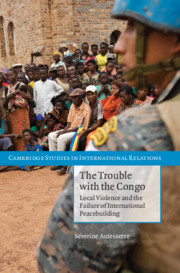Book contents
- Frontmatter
- Contents
- List of Figures and Tables
- Glossary of Acronyms, Names, and Ethnic Terms
- 1 Map of the Democratic Republic of the Congo and Its Neighbors
- Preface and Acknowledgments
- 1 The Peacebuilding World
- 2 A Top-Down Problem
- 3 A Top-Down Solution
- 4 A Bottom-Up Story
- 5 The Defeat of Bottom-Up Solutions
- 6 Beyond the Congo
- Appendix: Chronology
- Bibliography
- Index
- Cambridge Studies in International Relations
Preface and Acknowledgments
Published online by Cambridge University Press: 05 June 2012
- Frontmatter
- Contents
- List of Figures and Tables
- Glossary of Acronyms, Names, and Ethnic Terms
- 1 Map of the Democratic Republic of the Congo and Its Neighbors
- Preface and Acknowledgments
- 1 The Peacebuilding World
- 2 A Top-Down Problem
- 3 A Top-Down Solution
- 4 A Bottom-Up Story
- 5 The Defeat of Bottom-Up Solutions
- 6 Beyond the Congo
- Appendix: Chronology
- Bibliography
- Index
- Cambridge Studies in International Relations
Summary
This book grew out of the bewilderment I felt during my first visit to the Congo. I arrived in February 2001, a young humanitarian aid worker sent by Medicos Sin Fronteras (the Spanish section of Médecins Sans Frontières) to open its mission and projects in the country. I spent six months trying to understand the Congolese context so that Medicos Sin Fronteras could best respond to the humanitarian crisis, but felt I failed to reach beneath the surface. Whenever it seemed I was beginning to grasp the dynamics of violence, I found that my brand new framework of analysis would invariably collapse the next day. Congolese friends and humanitarian colleagues usually explained the conflict through a relatively simple macro framework, as a combination of two wars: an international confrontation between the Congo and Rwanda, and an ethnic conflict that pitted indigenous Congolese against ethnic Hutus and Tutsis with Rwandan ancestry living in the Congo. Yet this analysis not only failed to explain many aspects of violence, it also rendered certain dynamics even more puzzling. For example, why did indigenous Congolese ally with Rwandan Hutu armed groups? Why did some ethnic Tutsis ally with President Kabila, the indigenous Congolese's patron, to fight other ethnic Tutsis?
- Type
- Chapter
- Information
- The Trouble with the CongoLocal Violence and the Failure of International Peacebuilding, pp. xvii - xxiiPublisher: Cambridge University PressPrint publication year: 2010



